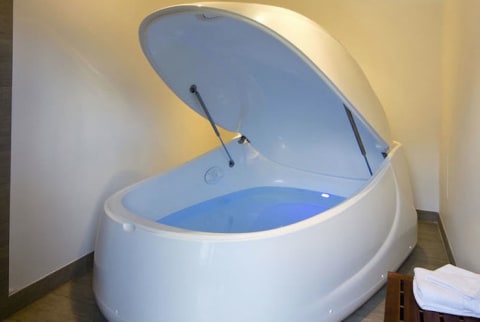Advertisement


The experience starts on a humid morning in Brooklyn. I'm at Lift/Next Level Floats, a newly-opened "sensory deprivation center" in Carroll Gardens. I’m whisper-greeted and asked to remove my shoes and sign a waiver. In the span of five minutes, I’ve waived liability, been shown to my “tank,” and left to shower myself clean and apply Vaseline to any open wounds.
At 9:30 am, I’m naked, freshly showered and covered in Vaseline. (OK, not “covered,” but I’d had an unfortunate encounter with my razor the night before and wanted to make extra-sure my skin was protected.)
It’s basically the Dead Sea of Brooklyn.
I also have to pee, and since the number one rule of sensory deprivation is “DO NOT PEE IN THE TANK!” (whispered, of course), I sneak down the hall to the bathroom where I can hear the hum of another tank being cleaned.
Ever the germaphobe, I’d researched the cleanliness of a communal tank before my visit. According to Lift's site, the water is “completely recirculated at least three times between each float through a 1 or 10 micron particulate filter, and then treated with either a combination of a germicidal UV lamp, ozone and hydrogen peroxide; or with a small amount of bromine.” I do not know what any of this means, but it sounds legit, and all the whispering has made me feel safe.
I return to my "Ocean Float Room" and open the door. A glorious sight meets my eyes: The float room is lit from above by a beautiful, constellation-like pattern of tiny bulbs from below by what can only be described as "mermaid essence."
Any unease I'd had about this experience is gone. I'm not afraid of salt, water or the dark. But sensory deprivation has an unsavory past — it was used to torture prisoners during the Korean War, and earned a bad rap in the 1960s when tank pioneer and scientist John C. Lilly started dosing himself with powerful hallucinogens before entering the tanks, and claimed to have communicated with long-dead historical figures during his floats.
I lower myself down into the tank, which has just one foot of water.
You might be thinking: But Allie, aren't you an average sized woman? How can one foot of water support you? But this is not just any foot of water. It's 12 inches of water mixed with 1,000 pounds of Epsom salt — it’s basically the Dead Sea of Brooklyn.
Not only will this water cradle me for 60 minutes of uninterrupted floating, it also promises to leave my skin silky and hair smooth upon emerging. No post-bath prune skin either: I’ll be moisturized and hydrated like never before.
Despite the staff telling me there’s no right or wrong way to float, it takes a while to get comfortable. I keep drifting into the walls and don’t know where to put my arms. I feel the salt water dribble into my ear and as memories of raging ear infections from childhood flood in, I grab the complimentary earplugs and inflatable neck pillow.
I set an intention for my float and lean into it.
Properly accessorized, I finally settle into a comfortable float position (something akin to a corpse, I imagine), and opt to turn off all the lights. If I’m going to try sensory deprivation, you better believe I’m going to deprive ALL my senses. It’s now pitch dark and silent.
I close my eyes (not that it makes a difference) and focus on breathing. I set an intention for my float and lean into it. I have no cares, I feel like I am in space. It’s blissful.
I nod off for a bit (apparently, this is pretty common) and when I come to, I’m sure my 60 minutes is almost over. It feels like I’ve been in this tank for a while and I’m pretty stress-free and my skin feels nice, so I expect the music that signals the end of the float will start any minute. But then 20 minutes (by my estimation) pass, and there’s still no music. Apparently I have grossly underestimated the amount of time left.
When the music does start, it’s pleasant enough but I make the mistake of turning on all the lights simultaneously. With the innocent push of a button, I aggressively reactive all my senses at once. It’s disorienting and good lord is it bright. I suddenly have empathy for newborns.
Colors are brighter, that classic New York smell is REAL, and are taxi horns really that loud all the time?
After my second shower of the day and a lot of vigorous eye rubbing, I dress, whisper thank you’s to the staff, and find myself back on the street that is all of a sudden way more vibrant than I remember. Colors are brighter, that classic New York smell is REAL, and are taxi horns really that loud all the time?
Sensory deprivation tanks promise total-body rehabilitation. Physically, they're effective at treating certain chronic pain and illness, and can even help with high blood pressure and fatigue. Mentally, floating is believed to help with stress by lowering levels of cortisol and allow for a deep state of relaxation (aka the perfect place for mediation). It's also supposed to help get creative juices flowing by removing distraction and instead allowing the floater to focus only on what's happening in his or her brain.
Fortunately, I don't suffer any ongoing ailments so I can't speak to the physical benefits of floating (though many professional athletes are allegedly big fans).
As for the psychological benefits, I certainly felt calm in the tank, but my 60 minutes of peace were negated by the heightened world outside. Maybe more frequent floaters reap bigger rewards.
What I can say with confidence is that my skin did feel soft all day, and now i know Vaseline is an excellent way to protect cuts from salt water.
Photo courtesy of Life: Next Level Float